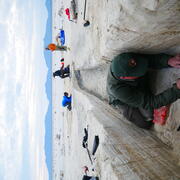Oceans and Estuaries
Sediments deposited in oceans and estuaries record past changes in conditions and processes that are fundamental to understanding Earth’s climate and systems. The Ecosystems Land Change Science Program conducts research on long-term patterns and drivers of ocean temperature, salinity, sea-ice, and productivity. The research supports development of models needed to inform management of marine areas













